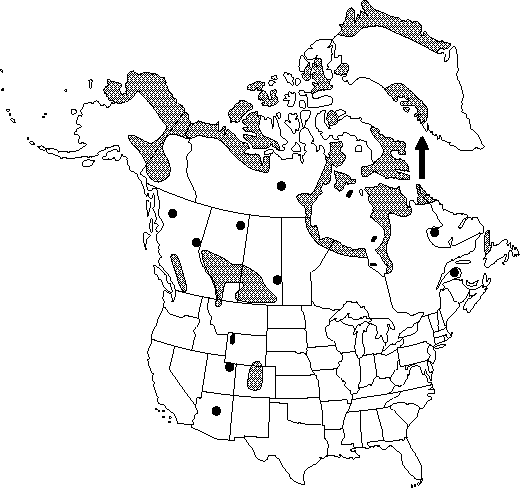Ranunculus pedatifidus var. affinis
Amer. Midl. Naturalist 52: 355. 1954.
Stems erect, 6-33 (-46) cm, pilose or glabrous, each with 1-7 flowers. Roots slender, 0.4-1.2 mm thick. Basal leaves persistent, blades cordate or reniform in outline, pedately (5-) 7 (-9) -parted or divided, 0.8-3.8 × 1-4.8 cm, segments undivided or again lobed or parted, base truncate to cordate, margins never toothed, apices of segments acute. Flowers: pedicels pilose; receptacle canescent; sepals 4-6 × 3-5 mm, abaxially pilose, hairs colorless; petals (0-) 5-10, 7-10 × 5-9 mm; nectary scale glabrous. Heads of achenes cylindric, 7-15 × 5-8 mm; achenes 1.8-2.4 × 1.6-1.8 mm, finely canescent or glabrous; beak lanceolate or subulate, curved, 0.5-1 mm. 2n = 32, 48.
Phenology: Flowering late spring–summer (Jun–Aug).
Habitat: Dry rocky places on open arctic and alpine slopes and shores, moist grassland depressions, and open aspen woods
Elevation: 0-3700 m
Distribution

Greenland, Alta., B.C., Man., Nfld. and Labr. (Nfld.), N.W.T., Ont., Que., Sask., Yukon, Alaska, Ariz., Colo., Mont., Utah, Wyo.
Discussion
Specimens of Ranunculus pedatifidus from southern Siberia, China, and central Asia, including the type specimen, are relatively small and slender, with all the main divisions of the leaf parted into narrow (1.5-2.5 mm wide) segments. American material, including the type of R. affinis, is more robust; the main divisions of the leaf are mostly undivided, and the ultimate segments are broader (2-4 mm). L. D. Benson (1954) referred all material from Asia and islands in the Bering Sea to var. pedatifidus. Other authors (P. N. Ovchinnikov 1970; E. Hultén 1968; A. I. Tolmatchew 1971), on the other hand, have limited typical R. pedatifidus to material from temperate Asia and have included material from northern Siberia in R. pedatifidus subsp. affinis. T. G. Tutin and J. R. Akeroyd (1993) included both R. pedatifidus and R. affinis in Flora Europaea, but, as noted below (under R. auricomus), Tutin and Akeroyd's descriptions do not match the American plants. Further comparisons of American and Eurasian material are needed.
Glabrous-fruited forms have been called Ranunculus pedatifidus var. leiocarpus (Trautvetter) Fernald; the variety was first described from Asia.
Selected References
None.